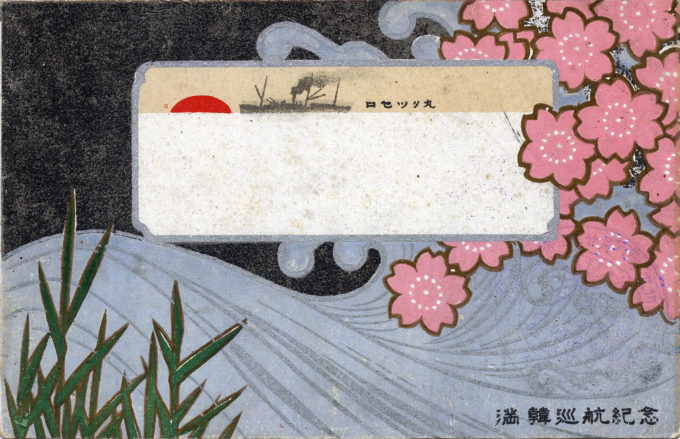
“Commemorative Cruise to Manchuria and Korea”, Rosetta Maru, 1906, published by the Asahi shimbun [Asahi newspaper], sponsor of the tourist cruises. The 3500-ton Rosetta was built for the P & O Line of Great Britain, and launched in 1880 for passenger service between England and Australia via the Suez Canal. In 1900, the vessel was sold to Toyo Kisen Kaisha (T.K.K.), and renamed Rosetta Maru. In 1907, the vessel would be sold again — this time to an entrepreneur interested in creating a ship-borne hotel docked between Tokyo and Yokohama.
See also:
Roseta hoter [sic], Tokyo, c. 1910.
“In 1906, the year following Japan’s much celebrated victory over Russia, Japan’s leading daily, the Asahi Newspaper Company, came up with the idea of organizing a group tour to the new colonies in order to capitalize on the newfound patriotic fervor. Though Japan had a long history of domestic tourism and community organized tours in the Tokugawa period, this was the first documented tour group made up of private Japanese citizens to visit foreign lands.
“With an eye to selling more newspaper subscriptions, the Asahi ran advertisements for a cruise to the frontier in order to re-live the great ‘battle-sites’ of the Sino- Japanese (1894-5) and Russo-Japanese wars (1904-5) depicted in memorabilia such as photographic albums, silk prints, and commemorative postcard sets favored by manic collectors.
“Three days following the first call for passengers leaving on the ‘Cruise Touring Manchuria and Korea’ in their June 22nd 1906 edition, all three classes of cabin tickets on board the Rosetta Maru were sold out when eighty people signed up.
“This was indeed an auspicious start for a first time media-engineered marketing pitch promoting Manchuria and Korea as ‘the new world’ where one could see for oneself the farthest edge of the Emperor’s authority and domain.’
“Following the media success of the 1906 tour as a cultural happening of the time, subsequent discounted tours began to be sold-out in large numbers giving rise to the ‘packaged educational tour’ as we know it today in Japan and Korea.”
– Navigating Modern Keijo [Seoul]: The Typology of Reference Guides and City Landmarks, by Hyung Il Pai, 2011

